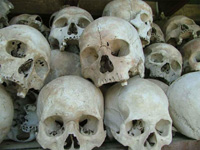Modern cannibalism originates from prehistoric times, study says
Heidelberg man who populated Europe some 700 thousand to 500 thousand years ago was a cannibal. The vault of a skull damaged by external action is the most irrefutable evidence of cannibalism.

The lyrics of one of the songs by the famous Russian songwriter Vladimir Vysotsky – One Scientific Mystery or Why the Aborigines Ate Captain Cook – seem to be perfectly appropriate to the debate about the spread of cannibalism among the ancestors of modern people: “From dusk till dawn they sat in the shade of azaleas,/ eating one another greedily,/ those wicked savages,/ in the sunlit Australia.”
Looks like the gory story really took place. More importantly, cannibalism was a widespread phenomenon not only in Australia, but in an area presently known as Spain.
The findings of a recent research conducted in the caves of Atapuerca in the northern part of the Pyrenean Peninsula show that the “Heidelberg man,” who used to inhabit the region, was a cannibal. The findings were made public by means of a report published by Spanish anthropologists. The Heidelberg man is thought to be a direct ancestor of both Neanderthal man and modern man.
Scientists had previously believed that the “holes full of bones” discovered in 1994 in Atapuerca contained the remains of humans who were the victims of either an epidemic or intertribal clashes. But things happened to be more complex than they looked at first sight.
“The remains of the people found in Atapuerca bear evidence of cannibalism. In other words, those people were eaten by other people,” says Professor Eudald Carbonel, head of the excavation party in Atapuerca. “The cutters of a special kind were used for paring meat off the bones which belong to ten representatives of the prehistoric man,” adds he.
On the whole, it is quite difficult to draw the line between an accident and a case of cannibalism. The vault of the skull damaged by external action is the most irrefutable sign of cannibalism. The damage indicates that the skull was broken by somebody who aimed to take the brain out if it.
Maria Mednikova, doctor of historical sciences, senior researcher at the Institute of Archeology of the Russian Academy of Sciences, makes a list of signs that will enable a researchers to tell injuries from end results of specific manipulations involving human mortal remains. “The latter include the signs of cuts, scraping, pits and shallow depressions on the bones, irregularities on the surface of joints and in locations where the muscles are attached to the bones, damage of the vault of a skull, fragmentation of a skull or postcranial skeleton, and the polishing of bone fragments’ edges,” says Mednikova.
Conducting the above analysis would be difficult task even using state-of-the-art equipment of today’s forensic medicine. Suffice it to say that 100% of evidence pertaining to all known hominids of Lower Paleolithic era (about 2 million years ago), 94.3% of Homo erectus, 76% of Neanderthal man, and 73% of evidence relating to man of Upper Paleolithic age (about 10 thousand years ago) is represented by individual bones, or by a single bone in most cases.
A detail that came to light during the study of the “feast of the cannibals” looks like a real tearjerker. “The tribe of cannibals most likely ate the people of other tribes for ritual purposes. Hunger was not their motivation when they ate their neighbors. The young species of both sexes were the main course of choice,” says the report prepared by Prof. Carbonel’s team.
By one way or another, the tradition of cannibalism started by the Heidelberg man became quite popular among the representatives of later ages. All the subsequent hominids practiced cannibalism. Evidence found in the ground where the cliff of Crapina overhangs nearby the present-day city of Zagred, Croatia, is arguably the most mysterious cannibalistic case.
Aside from the bones and skulls of more than 20 Neanderthals of different ages found on location, researchers also dug out numerous animal bones pertaining to Merck’s rhinoceros, a wild bull, a cave bear, a boar, and a deer. The human and animal bones alike had clear signs of the “specific manipulations” e.g. the bones were split into many pieces, some of them were scorched; several skull vaults were perforated and so on. Judging by the skulls found near the cliff, not only the typical Neanderthals inhabited in Crapina. Some skulls belong to human beings who have a great deal of resemblance between them and modern humans.
According to one of the theories, Crapina is thought to be the site of a “battlefield” between the Neanderthals and the Cro-Magnon. If the theory holds water, either the former or the latter would have been eaten after losing the battle. But the fractured skull remains indicate that representatives of both populations fell victims to cannibalism. The question is: Who ate those poor fellows? Not to mention the rhinoceroses and bears.
Perhaps a third party was involved in the Crapina mystery. The third party may have represented some new genus of intelligent species, apart from the Neanderthal man and homo sapience. So where are you, the third one? It takes three to crack a bottle or so the saying goes.
Nezavisimaya Gazeta
Translated by Guerman Grachev
Pravda.Ru
Discuss this article on Pravda.Ru English Forum
Subscribe to Pravda.Ru Telegram channel, Facebook, RSS!


